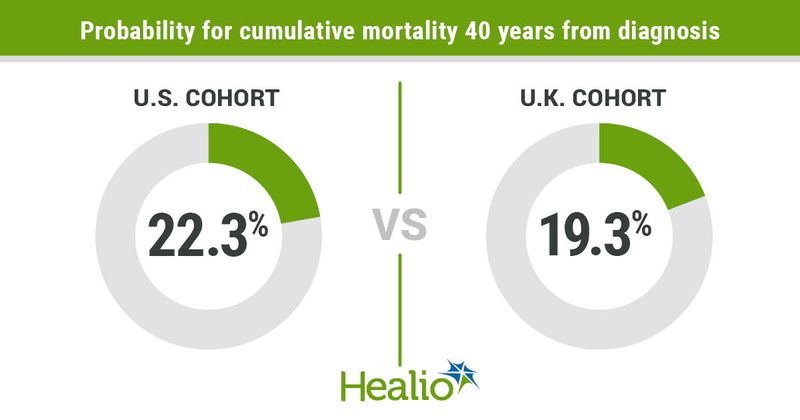US childhood cancer survivors have higher long-term risk for death than UK counterparts
U.S. childhood cancer survivors had worse long-term survival outcomes than U.K. survivors, which suggests they may have undergone more intensive treatment, according to study results published in Journal of the National Cancer Institute.
“For decades it has been shown, to varying degrees, that long-term survivors of childhood cancer are at risk for adverse health outcomes due to the cancer treatments they receive,” Miranda M. Fidler-Benaoudia, PhD, research scientist and epidemiologist in the department of cancer epidemiology and prevention research at Alberta Health Sciences, told Healio. “Studies have been conducted around the world to understand these late effects, but no study to our knowledge compared late-effects risks between countries.”

For this reason, Fidler-Benaoudia and colleagues compared long-term survival outcomes of 5-year survivors of childhood cancer, diagnosed before age 15 years and between 1970 and 2000, who participated in the Childhood Cancer Survivor Study (n = 31,596, all from the U.S.) and the British Childhood Cancer Survivor Study (n = 18,226). They used cumulative mortality probabilities and adjusted ratios of the standardized mortality ratio (RSMRs) to assess mortality risk.
The cohorts had similar characteristics, including percentages of male survivors (55.9% U.S. vs. 56% U.K.) and those diagnosed at age 0 to 4 years (49.8% vs. 46.1%). The most common diagnosis in each cohort was acute lymphoblastic leukemia (38.1% vs. 36.6%).
Overall, 6,375 deaths occurred, including among 12.4% of survivors in the U.S. cohort and 13.4% of those in the U.K. cohort. The U.S. cohort had a lower overall risk for all-cause mortality, with a RSMR of 0.8 (95% CI, 0.8-0.9) and an excess mortality ratio of 0.9 (95% CI, 0.8-1.0).
At 10 years from diagnosis, researchers observed significantly lower probability of all-cause cumulative mortality among the U.S. cohort (4.7%; 95% CI, 4.5-5) compared with the U.K. cohort (6.9%; 95% CI, 6.5-7.2), which appeared attributable to a lower probability of death due to primary cancer recurrence or progression.
However, at 40 years from diagnosis, the U.S. cohort had higher probability for cumulative mortality (22.3% vs. 19.3%) that appeared attributable to a twofold higher risk for mortality due to subsequent malignant neoplasms and cardiac and respiratory diseases, as well as other health-related causes.
Researchers observed a 60% higher risk for death among survivors of lymphoma in the U.S. cohort compared with the U.K. cohort, with an RSMR and excess mortality ratio of 1.6 (95% CI, 1.3-1.8), whereas U.S. survivors of central nervous system tumors and leukemia had significantly lower risks for all-cause mortality according to these measures.
Analysis by cause of death showed the main contributor to the differences between the cohorts was death due to recurrence or progression, with U.S. survivors experiencing significantly fewer recurrence/progression deaths (excess mortality ratio = 0.6; 95% CI, 0.6-0.7). These differences remained stable over the period studied and, as a result, the all-cause mortality gap widened in later years. Among survivors diagnosed between 1990 and 1999, those in the U.S. cohort experienced half as many excess deaths as those in the U.K. cohort (RSMR = 0.5; 95% CI, 0.5-0.6).

“Our study suggests that children in the U.S. may be treated more intensely compared to children in the U.K., which led to a decreased risk for death from recurrence or progression among childhood cancer survivors, but an increased risk for death due to a health condition likely caused by the cancer treatment among those in the U.S. cohort, such as a second cancer or cardiovascular disease,” Fidler-Benaoudia said. “However, as the U.K. data unfortunately did not have detailed treatment information, we cannot be certain that the differences observed between the two countries were due to differences in treatment strategies; thus, this is just our hypothesis. That said, as clinicians and researchers are continually trying to improve health outcomes for survivors of childhood cancer either with new treatments or modifying existing protocols, our study highlights the delicate balance of improving survival rates without increasing the risk for late effects due to cancer therapies.”
Due to the fundamental design differences between the two studies, it is important to validate these findings using other data, Fidler-Benaoudia added.
“For example, it could be useful to compare the U.K. cohort with the U.S. SEER program, as they are both population-based, or the U.S. cohort should be compared with other clinical cohorts that have detailed treatment information,” she said.
Regardless of whether or not the results of the current study reflect true differences in long-term cumulative mortality, they emphasize the need to monitor the health of childhood cancer survivors, according to an editorial accompanying the study by Lisa Gallicchio, PhD, and Kathy J. Helzlsouer, MD, MHS, both researchers in the division of cancer control and population sciences at the NCI.
“Continued efforts to quantify cumulative disease burden, conduct risk prediction modeling to personalize follow-up care and generate cost-effectiveness models to define optimal type and frequency [of] surveillance will help to elucidate pathways of survivorship follow-up for childhood cancer survivors who are most in need,” they wrote. “Most importantly, ensuring access to both treatment and continued follow-up to enable prevention, recognition of late effects and prompt intervention are crucial, especially in the absence of universal health care in the U.S. These types of activities will greatly help in going beyond what are already considered tremendous advances in the treatment and care of individuals diagnosed with a childhood cancer, with the ultimate goal of improving the health and quality of life of this population.”
References:
For more information:
Miranda Fidler-Benaoudia, PhD, can be reached at Alberta Health Services, Room 508B, Holy Cross Center, 2210 2 St. SW, Calgary, AB T2S 3C3; email: miranda.fidler-benaoudia@ahs.ca.
